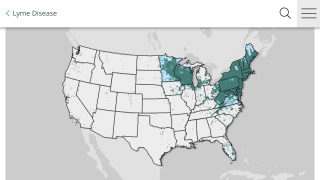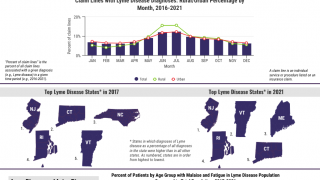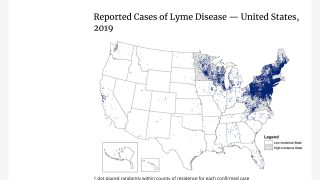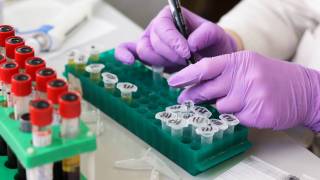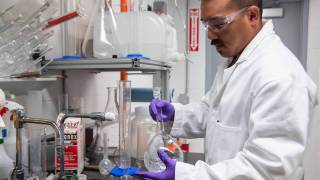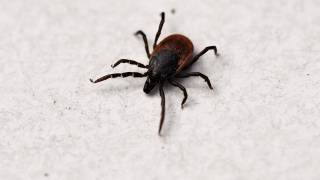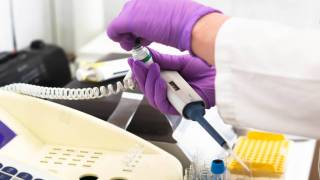Lyme Disease Detection May Soon Have a Better Test

Tick-borne diseases (TBDs) are the most common vector-borne diseases in the USA.
As of the end of 2017, 19 different bacterial, protozoan and viral agents have been implicated in TBDs.
Each year, approximately 3 million specimens are tested for TBDs.
Moreover, Borrelia burgdorferi, the causative agent of Lyme disease accounts for an estimated 300,000 annual cases of TBDs.
Lyme disease in North America is transmitted by black-legged Ixodes scapularis and Ixodes pacificus ticks.
“The true incidence of TBDs is likely greatly underestimated, as patients with presumed TBDs are rarely tested for the full range of tick-borne agents, and only a fraction of positive cases are properly reported,” said Nischay Mishra, Ph.D.
The most frequently employed serologic assays for TBD diagnoses include the enzyme-linked immunosorbent assay (ELISA), indirect immunofluorescent assay (IFA), and western blot.
For Lyme disease, the recommended method for diagnosis is a 2-tiered testing algorithm, consisting of an ELISA followed by supplemental western blots.
Lyme disease misdiagnosis may be because ticks frequently carry more than 1 type of pathogen.
“The number of Americans diagnosed with tick-borne diseases is steadily increasing as tick populations have expanded geographically,” says Rafal Tokarz, Ph.D.
But, the test accuracy is less than 40 percent in patients with early disease and can result in up to 28 percent of IgM western blots yielding false positive results.
Recently, researchers developed the first multiplex, an array-based assay for serodiagnosis of tick-borne diseases called the TBD-Serochip.
Led by scientists at the Center for Infection and Immunity (CII) at Columbia University’s Mailman School of Public Health, this research team reports details on this new test in the journal Nature Scientific Reports.
The TBD-Serochip was designed to discriminate antibody responses to 8 major tick-borne pathogens present in the United States, including Anaplasma phagocytophilum, Babesia microti, Borrelia burgdorferi, Borrelia miyamotoi, Ehrlichia chaffeensis, Rickettsia rickettsii, Heartland virus and Powassan virus.
At present, the TBD Serochip is not available for use in a clinical setting. Further testing is needed to determine safety and efficacy, said these researchers.
John Snow Professor of Epidemiology at Columbia University’s Mailman School of Public Health said, “The TBD Serochip promises to make diagnosis far easier, offering a single, accurate test for eight different TBDs.”
“Early detection of infection enables rapid and appropriate treatment.”
Co-authors include Thomas Briese, Teresa Tagliafierro, Stephen Sameroff, Adrian Caciula, Lokendrasingh Chauhan, of CII; Jigar Patel and Eric Sullivan of Roche Sequencing Solutions, Madison, WI; Azad Gucwa of Farmingdale State College, Farmingdale, NY; Brian Fallon of Columbia University; Marc Golightly of Stony Brook University; Claudia Molins and Martin Schriefer of Centers for Disease Control and Prevention; and Adriana Marques of National Institute of Allergy and Infectious Diseases.
This study was funded through grants from the Steven & Alexandra Cohen Foundation and the National Institutes of Allergy and Infectious Diseases (AI109761). The content of study does not necessarily reflect the views or policies of the Department of Health and Human Services, nor does mention of trade names, commercial products, or organizations imply endorsement by the U.S. government.
In a separate vaccine study, Valneva a biotech company announced positive interim results for its Lyme vaccine candidate, VLA15.
VLA15 is a multivalent, protein subunit vaccine, and is currently the only active vaccine program in clinical development against Lyme disease.
This vaccine candidate was granted Fast Track designation by the U.S. Food and Drug Administration (FDA) in July 2017.
In this small, phase 1 study, VLA15 was reported to have met its primary endpoint which was to evaluate the vaccine candidate's safety and tolerability profile at different dose levels and formulations.
Our Trust Standards: Medical Advisory Committee
- Lyme Disease Vaccine Candidate VLA15 Reports Clinical Study Success
- A multiplex serologic platform for diagnosis of tick-borne diseases
- First Multiplex Test for Tick-Borne Diseases
- Lyme Disease Coinfections in the United States
- Pathogen transmission in relation to duration of attachment by Ixodes scapularis ticks


